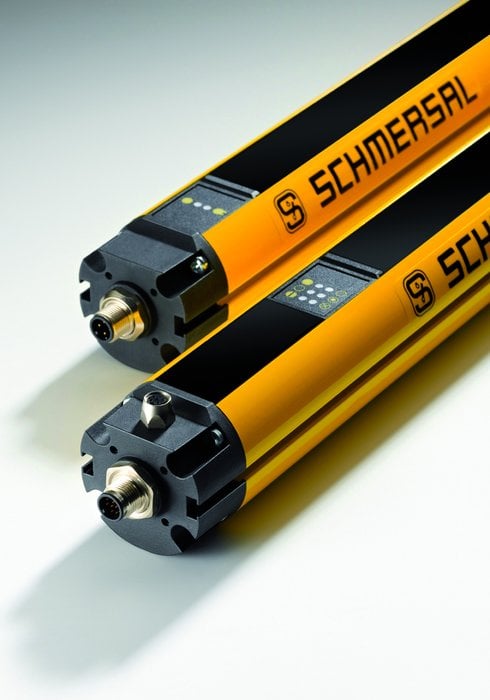www.industryemea.com
22
'10
Written on Modified on
SLC 420 Series
Thanks to a teach-in function for blanking, these Safety light grids offer flexibility when securing hazardous areas with optoelectronics

Compared to conventional safety doors, optoelectronic safety guards often provide for a more flexible machine operation. The operator’s flexibility is even enhanced, when safety light curtains with comfortable parameterizable muting and blanking functions are used.
The “blanking” feature enables an area in the protection field to be blanked out without a stop signal being triggered. In this way, a conveyor belt or an auxiliary or support construction of the machine can be positioned in this area. The “floating blanking” feature provides for enhanced flexibility. With this function, light beams can be blanked at non-permanently defined positions. This is useful, when objects such as movable electrical cables are located inside the protection field. The blanking is moving up or down together with the object to be blanked – this explains the “floating” designation. If the object size changes, the safety light grid is switched off.
In the SLC 420 series, all light beams except the synchronisation beam can be used for blanking. Different blanking functions are available: a fixed blanking and a dynamic blanking. The chosen mode depends on the duration of the presence of the object (permanently either temporarily) in the protection field. In this way, the user can flexibly adjust the blanking function to the individual application.
These functions become ever more popular in actual practice; as a matter of fact, the flexible production trend also extends to the non-contact safety guards. Safety Control GmbH – the Centre of Competence of the Schmersal Group for optoelectronic safety guards – now has developed a new series of safety light curtains, for which the blanking function can be parameterized without PC software or programming device. In the SLC 421 series, these functions are defined in the teach-in mode using external command devices.
The user activates the desired teach-in mode through a key-operated selector switch; the light curtain is equipped with a LED, which indicates the operating mode. The teach-in procedure is started by means of an external command device, e.g. a foot switch. In this way, the operator defines the areas to be blanked. During this procedure, he can choose between fixed blanking, fixed blanking with one or two additional floating beams and last but not least floating and fixed blanking.
The “blanking” feature enables an area in the protection field to be blanked out without a stop signal being triggered. In this way, a conveyor belt or an auxiliary or support construction of the machine can be positioned in this area. The “floating blanking” feature provides for enhanced flexibility. With this function, light beams can be blanked at non-permanently defined positions. This is useful, when objects such as movable electrical cables are located inside the protection field. The blanking is moving up or down together with the object to be blanked – this explains the “floating” designation. If the object size changes, the safety light grid is switched off.
In the SLC 420 series, all light beams except the synchronisation beam can be used for blanking. Different blanking functions are available: a fixed blanking and a dynamic blanking. The chosen mode depends on the duration of the presence of the object (permanently either temporarily) in the protection field. In this way, the user can flexibly adjust the blanking function to the individual application.
These functions become ever more popular in actual practice; as a matter of fact, the flexible production trend also extends to the non-contact safety guards. Safety Control GmbH – the Centre of Competence of the Schmersal Group for optoelectronic safety guards – now has developed a new series of safety light curtains, for which the blanking function can be parameterized without PC software or programming device. In the SLC 421 series, these functions are defined in the teach-in mode using external command devices.
The user activates the desired teach-in mode through a key-operated selector switch; the light curtain is equipped with a LED, which indicates the operating mode. The teach-in procedure is started by means of an external command device, e.g. a foot switch. In this way, the operator defines the areas to be blanked. During this procedure, he can choose between fixed blanking, fixed blanking with one or two additional floating beams and last but not least floating and fixed blanking.

